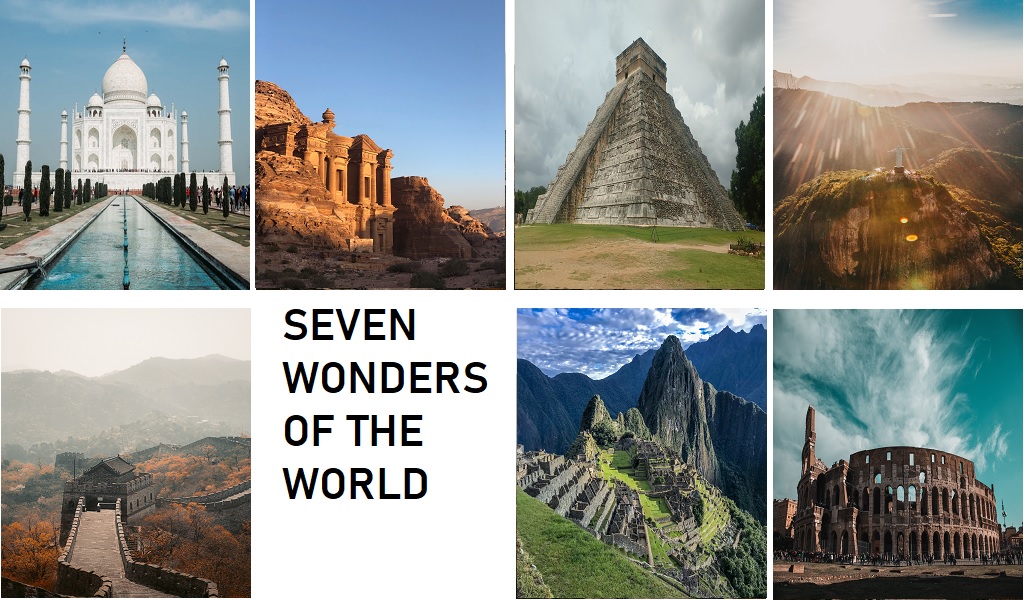Seven wonders of the world are the places that one must watch in a lifetime. They are not only a means of recreation. But an artistic perspective that incorporates within them beauty, logic, love, and science. They make people realize the richness and intelligence that existed in the past when men were skilled, efficient, and innovative like the era of technology today.
Plan a visit to 7 wonders of the world if you want to experience unique artistic style, quality architecture, and monuments that withhold history behind. They stand high against all odds of Nature and Time. Fascinating stories behind the structures and brilliant architect leaves the visitors wondering about the intelligence and wisdom of the creators. Every year there are millions of visitors visiting the masterpieces and adding to the tourism industry.
If planning a visit to the seven wonders of the world, the following information will add to your knowledge and excitement. We bring for you the facts, numbers, years, history, and everything that will excite you to have a watch at the masterpieces that are capable of evoking questions and keep the mind wondering for long. Information will help you to understand better and get more close to the wonders that are the epitome of creativity and magnificence.
7 wonders of the world
Taj Mahal- India
Famous as the symbol of love, the Taj Mahal is in Agra, India. It is a structure that took 20 years, 20 000 labourers, and 1000 elephants to complete. It is the spectacular artwork that shines bright on white marble that takes away the heart of many tourists visiting it all across the world. Shah Jahan built the structure in the loving memory of his beloved wife, Mumtaz Mehal.
It is pinkish-blue in the morning, milky-white in the evening, and golden at night. The architectural style of the Taj Mahal is an amalgam of Islamic, Persian, Ottoman Turkish, and Indian architectural styles. The white dome at the peak of the mausoleum is beautiful and surrounded by four small domes. The mausoleum houses the tomb of Mumtaz and her husband, Shah Jahan. UNESCO declared the Taj Mahal as World Heritage in 1893.
Colosseum-Rome
The colosseum pride of Rome is a masterpiece. It is an oval-shaped amphitheatrical structure that can seat more than 80,000 spectators. Construction of the Colosseum began in 72 years under the reign of Vespasian. It finished during the rule of the emperor Titus in the year 80. In ancient times Roman colosseum known as Flavian Amphitheatre seated more than 50,000 people to witness events like daring gladiator fights, exhibitions of exotic animals, executions of prisoners.
Today it attracts tourists in millions as it stands as a sign of Imperial Rome. Archaeological findings and research suggest that the structure was active for 500 years, till the 6th century. After the 6th century, it suffered lootings, earthquakes, and even bombardment during world war II. Nothing much of the structure was devastated during all these catastrophes. Instead, later it was a place for offering prayers, Church. It also became a storehouse, cemetery, and castle of nobility.
Machu Pichu-Peru
Between the high ridges of Huayna Picchu and Machu Picchu mountains in Peru is located Inca site of the 15th century, Machu Pichu. The site is an example of architectural skills that had the potentials to withstand shakes of earthquakes. The location site of the structure is geologically above the fault zone which, means that there should be no trace of the buildings in this zone due to the collapsing of buildings caused by trembles of the earthquake.
However, ironically the site hosts many beautiful structures still standing. It is due to the engineering perfection that facilitates the arrangement of stones in a way that during earthquake trembles, rocks bounce, and dance and falls back at their place. The site was unexplored by Hiram Bingham III, a professor at Yale University who was searching for Vilcabamba, the last capital of Incas before the Spanish conquest. The housing structure at the site signifies the construction of Machu Pichu as a Royal estate by Pachacuti Inca Yupanqui, the ninth ruler of Incas.
Christ Redeemer-Brazil
Christ Redeemer in Brazil overlooks the city of Rio de Janeiro. It is the amalgamation of science and art that makes this statue add to the seven wonders. From far, it looks like a cross across the sky. It is when one goes close to the structure one sees a perfect proportion of the human figure. The concrete that makes the statue is of light colour that reflects the variant shades at sunrise, sunset, and moonrise.
The engineers and architectures have worked in a close niche with each other while designing and making this statue. The internal areas of the statute make a way to reach the top and extending sides of the structure for maintenance and cleanliness. The location of the statue over a peak overlooking the city strengthens the feeling of people that God is shielding them against all odds and evens. Brazilian engineer and architect Heitor da Silva Costa designed the statue. But the ideas of other sculptors and designers do find their trace in the magnificent work of art.
Chichen Itza –Mexico
Chichen Itza is relics of a ruined Maya city spread over an area of 4 sq miles in Mexico. In 550, people chose it as a site for settlement because of the availability of water through geological structures of caves and sinkholes in the semi-arid region, cenotes. The place gets its name from the presence of two cenotes.
El Castillo is a famous pyramid at Chichen Itza that astrological authorities aim to preserve for the coming generations. Other structures that constitute the part of Chichen Itza are the Great Ball Court, the Temple of the Warriors, the Sacred Cenote, and more. The archaeological findings reveal Chichen Itza was a magnificent piece of archaeological designs and patterns. The place reflects the cultural significance and importance of water for the existence of civilization. Chichen Itza abodes many cenotes or, in other words, cenote led to the origin of Chichen Itza.
Petra-Jordan
Petra, due to its strategic location between the Red Sea and Dead sea, facilitated trade activities for the silks of China and the spices of India. Petra is a half-built structure amidst the gorges and mountains that are hidden pathways. The water management system gave way to the existence of a settlement in this arid zone. Extensive tunnels, reservoirs, canals in the region are self-explanatory about the understanding of people in trapping the natural sources of water and preserving them for existence.
The site withholds the structures made of sandstone that make it challenging to maintain integrity because of the ease with which sandstone gets eroded. Other challenges come from a flash flood that results from the widening of the nearby gorge. Tourism is another threat that endangers the fragile piece of art.
Great Wall of China
The great wall of China is a remarkable example of human engineering. The wall is half the length of the equator that has different elevations at different parts. It is 2700 years old, although the entire wall is not that old. Some portions got constructed in the 7th-century bc, while others date back to the Ming dynasty (1368–1644).
The structure is not in a straight line and uniformity. Instead, it comprises of many forts and walls that owe their existence to different times, but with one purpose of defence and safety. However, historical pieces of evidence prove that the wall was not always able to defend the penetration of the enemy. In the 13th century, Gengis Khan penetrated the country and ruled for 100 years over it with his army after penetrating through the wall. It is the interference of human activities, and some part played by natural agents of degradation that one-third of the wall has already disappeared.
Final Thoughts:
Seven wonders of the world have a lot to offer to today’s field of art, architecture, engineering, and style. Each of the constructions leaves the present generation wondering about the intelligence and thought processes architects and engineers of that time used to trap the natural energies and make most of them in every way and form. It shows us the respect they had for Nature and how they understood it so wisely that they worked in close kinship with it.
Seven wonders of the world have a lot for everyone who has an eye to see the beauty and understand the logic behind each construction that is a masterpiece in itself. While planning the visit to them, one must try to know more and more about the structures to double the enjoyment and wonder these structures present. The sites are self-explanatory and descriptive. Close observation and association will help the person to find answers to many questions that these sites have the power to raise.
Getting the opportunity to visit the seven wonders of the world is not something to miss out on or even give a second thought. Go through the following facts and information about seven wonders and realize how lucky you are to get the one, and grab it. Reading about them will raise goosebumps so, think about what their site could do to you.

















